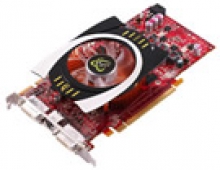XFX 6800GS
2. Features
As already mentioned, the 6800GS card comes in to replace the 6800GT card. But there are some major differences between these two cards. First of all, the GS model uses the new NV42 architecture, while the GT model used the NV40. This means that a whole different manufacturing architecture is embedded in the 6800GS card.
The old 6800GT operated with 16 pixels shader and 6 texture shader pipelines, but the new 6800GS runs with only 12 pixels shader and 5 texture shader pipelines. But even with reduced pixels shader and texture pipelines, the 6800GS still manages better performance than a 6800GT. The secret is hidden within the chipset architecture. The new chipset technologies and the higher clock rates leave more room for the card to show us its true value. According to nVidia: “the default running frequency for the new 6800GS card is 425MHz core clock and 500MHz memory clock”. We should remind you that the old 6800GT card was clocked at 350MHz (core clock) with the same running frequency for the memory clock. All these clocks apply to the standard reference 6800GS board and NOT to the XFX 6800GS XXX Edition. Read on to see what more the XFX has to offer.
- Key Features
- CineFX 3.0
![]() This is a groundbreaking new hardware technology that pushes 3D real-time graphics one step closer to film quality. It offers infinite length shader programs, dynamic flow control, displacement mapping, vertex frequency stream divider and Multiple Render Target (MRT) technology. Previously, highly complex effects were not possible without sacrificing
performance and precision, because of long shader programs that required many
computational passes. Now, with the CineFX 3.0
engine, groundbreaking effects can be created without compromising performance.
This is a groundbreaking new hardware technology that pushes 3D real-time graphics one step closer to film quality. It offers infinite length shader programs, dynamic flow control, displacement mapping, vertex frequency stream divider and Multiple Render Target (MRT) technology. Previously, highly complex effects were not possible without sacrificing
performance and precision, because of long shader programs that required many
computational passes. Now, with the CineFX 3.0
engine, groundbreaking effects can be created without compromising performance.
- SLI enabled

The NVIDIA nForce4 Scalable Link Interface (SLI) technology allows two graphics processing units in a single computer. This technology takes advantage of the PCI Express bus architecture and features intelligent hardware and software solutions that allows multiple GPUs to work together and achieve exceptional performance.
- UltraShadow II
More photo-realistic scenes and environments in your games, without compromising PC performance. Complicated lighting and shadow effects become practical and next-generation games rise to the next level in cinematic realism. - Pixel Shader Model 3.0
Better performance and more realistic shades to produce high quality images within games. - High-Speed GDDR3 memory interface
- NVIDIA High-Precision Dynamic-Range (HPDR) technology
NVIDIA HPDR sets new standards for image clarity and quality through floating point capabilities in shading, filtering, texturing, and blending. - NVIDIA® Intellisample™ 3.0 technology
The industry's fastest anti-aliasing delivers ultra-realistic visuals, with no jagged edges, at lightning-fast speeds - NVIDIA nVIEW Multi-display technology
Advanced technology provides the ultimate in viewing flexibility and control for multiple monitors.

- Specifications
The XFX 6800GS specifications, as given by XFX, are shown below:
| Engine Clock | 485MHz (vs standard at 425MHz) |
| Memory Clock | 1.1GHz (vs standard at 1GHz) |
| Chipset | GeForce 6800 GS |
| Memory | 256 MB |
| Bus Type | PCI-E |
| Memory Type | DDR3 |
| Memory Bus | 256-bit |
| Output | DVI |
| Highlighted Features | TV Out , HDTV ready , SLI ready |
| Graphics Core | 256-bit |
| Memory Interface | 256-bit |
| Memory Bandwidth | 32 GB/sec |
| Vertices Per Second | 531 Million |
| Pixels per Clock (peak) | 12 |
| Textures per Pixel | 12 |
| RAMDACs | 400 MHz |
| Fill Rate | 5.1 Billion Texels/sec. |
| Memory Date Rate | 1000 MHz |
As you can see, the XFX 6800GS XXX Edition is overclocked even further. It runs at 485MHz core clock while the memory is clocked at 550MHz. It is very interesting to see how far we can go with the (stock overclocked) XFX 6800GS. We should also mention that there is also a 6800GS Extreme edition available on the market, that is clocked at 450MHz core clock and 525MHz (1.05GHz) memory clock.





















